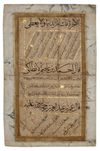AN ILLUMINATED CALLIGRAPHY ATTRIBUTED TO YAQUT AL-MUSTA’SIMI, BAGHDAD, LATE 13TH CENTURY
An Arabic manuscript on paper, depicting calligraphies in different scripts. The upper section depicts a saying by Mutarrif ibn Abdulallah in black naskh script, the middle section with poems written by Ahmed ibn Assem Al-antaki in black Muhaqqaq script. The lower section depicting a saying by Omer ibn Abdalziz, the well-known Umayyd caliph. all within a later gilded borders. 31 by 17.8 cm.
Yaqut al-Musta’simi is one of the most famous and admired, perhaps the most celebrated, of Islamic calligraphers. His full name was Abu’l Majd Jamal al-Din Yaqut ibn ‘Abdullah, and he was born, it is thought, in the early 13th century, in Anatolia, though there have been suggestions that he was Abyssinian. The name Yaqut, ‘ruby’, was a common one for slaves, and he is supposed to have been brought as a slave (possibly also converting to Islam) to Baghdad in his youth in the service of the last Abbasid caliph, al-Musta’sim billah (whence his epithet). He was official secretary (katib al-diwan) there and managed to survive the sack of the city by the Mongols in 1258. He studied calligraphy with one of the masters of that period, Safi al-Din ‘Abd al-Mu’min al-Urmawi (d. 1294), and also under Juwayni, becoming librarian of the famous Mustansiriyyah madrasa. He died in around 697AH/1298 AD. Yaqut was always spoken of for his mastery of the ‘Six Pens’, notably thuluth, and also for developing a new style of naskhi script by trimming the nib of his pen differently. He was said to have practiced calligraphy every day by copying two sections of the Quran, maintaining this practice (so legend had it) even during the Mongol siege, by hiding at the top of a minaret. Yaqut al-Musta'simi is one of the most famous and admired, perhaps the most celebrated, of Islamic calligraphers. His full name was Abu'l Majd Jamal al-Din Yaqut ibn 'Abdullah, and he was born, it is thought, in the early 13th Century, in Anatolia, though there have been suggestions that he was Abyssinian. The name Yaqut, 'ruby', was a common one for slaves, and he is supposed to have been brought as a slave (possibly also converting to Islam) to Baghdad in his youth in the service of the last Abbasid caliph, al-Musta'sim billah (whence his epithet). He was official secretary (katib al-diwan) there and managed to survive the sack of the city by the Mongols in 1258. He studied calligraphy with one of the masters of that period, Safi al-Din 'Abd al-Mu'min al-Urmawi (d. 1294), and also under Juwayni, becoming librarian of the famous Mustansiriyyah madrasa. He died in around AH 697/AD 1298. Yaqut was always spoken of for his mastery of the 'Six Pens', notably thuluth, and also for developing a new style of naskhi script by trimming the nib of his pen differently. He was said to have practiced calligraphy every day by copying two sections of the Quran, maintaining this practice (so legend had it) even during the Mongol siege, by hiding at the top of a minaret.

